Happy Monday! U.S. Olympians are bringing the very best of America to France for the Olympics later this summer—including, apparently, air conditioning units.
Quick Hits: Today’s Top Stories
- In an 8-1 decision on Friday, the Supreme Court upheld a federal law that blocks anyone with a domestic violence restraining order against them from owning a gun, deciding the law does not violate the Second Amendment under the history and tradition test set out in New York State Rifle & Pistol Association v. Bruen from 2022. Only Justice Clarence Thomas dissented from the majority opinion—authored by Chief Justice John Roberts—though several justices in the majority wrote concurring opinions explaining their differing interpretations of the Bruen standard. Also on Friday—in Department of State v. Muñoz—the court held in a 6-3 decision, authored by Justice Amy Coney Barrett and joined by the other conservative members of the court, that U.S. citizens cannot challenge the visa denial of their non-citizen spouses based on their own rights as citizens.
- Gunmen opened fire on a church, a synagogue, and a police checkpoint in two cities in the southern Russian province of Dagestan on Sunday, killing more than 19 police officers and several civilians, including an Orthodox priest, in a coordinated attack that no group has yet claimed. State media reported that Russian authorities killed six of the gunmen. The attackers set fire to both the church and the synagogue. Dagestan, Russia’s predominantly Muslim southernmost province, has previously been the site of Islamist attacks.
- Israeli Defense Minister Yoav Gallant arrived in Washington, D.C., on Sunday as Prime Minister Benjamin Netanyahu doubled down on accusations that the Biden administration has decreased its supply of armaments to the country—allegations U.S. officials have said are unfounded. Gallant is set to meet with his American counterpart, Secretary of Defense Lloyd Austin, and Secretary of State Antony Blinken, and will likely discuss the heightened hostilities with Hezbollah—an Iranian-backed terrorist organization attacking northern Israel from Lebanon. On Saturday, the Israel Defense Forces (IDF) carried out an airstrike near Gaza City, reportedly in the vicinity of the built-up Al-Shati refugee camp, which Hamas claimed killed civilians. The IDF said it “struck two Hamas military infrastructure sites in the area of Gaza City” in an operation that reportedly targeted a senior Hamas commander, Raad Saad, though his condition is unknown.
- On Friday Russia launched its eighth widespread attack on Ukraine’s energy infrastructure in the last three months, though the Ukrainian air force said air defenses intercepted 12 of the 16 missiles and all of the 13 drones Russia launched at the civilian infrastructure in several regions across the country. On Saturday, Russia’s bombing of a residential building in the northern city of Kharkiv killed at least three people and injured more than 30 others, local authorities said.
- A gunman killed four people and injured nine others at a grocery store in Fordyce, Arkansas, on Friday morning, before police arrested the suspected shooter, a 44-year-old man from a nearby town. The suspect was charged with four counts of capital murder for what the director of the Arkansas State Police described as “a completely random, senseless act” without a clear motive or target.
- U.S. Central Command announced Saturday that the USS Dwight D. Eisenhower aircraft carrier, deployed to the Red Sea for the last nine months, will leave for the Mediterranean before returning to the United States. The USS Theodore Roosevelt carrier strike group will take the Eisenhower’s place in the Red Sea after a scheduled exercise in the Indo-Pacific. The U.S. Navy has described the Eisenhower’s twice-extended combat deployment as the most “intense” since World War II amid ongoing attacks on international waterways by the Iranian-backed Houthi rebels.
- Saudi Arabian officials said Sunday that the number of people who have died while visiting Mecca on Islam’s yearly pilgrimage has risen to some 1,300 pilgrims from across the globe, most of whom did not hold official permits to complete the Hajj pilgrimage and therefore did not have hotels for escaping the extreme heat. Temperatures in Saudi Arabia climbed to around 120 degrees Fahrenheit on some days of the nearly weeklong ritual, which involves walking outside in the holy city of Mecca.
- A Clark County, Nevada, judge on Friday dismissed the state’s case against six false electors who allegedly fraudulently certified that former President Donald Trump won the 2020 presidential election in that state. The judge ruled that Clark County was not the correct jurisdiction for the case, though prosecutors have indicated they’ll appeal the decision.
SCOTUS Opinion-palooza
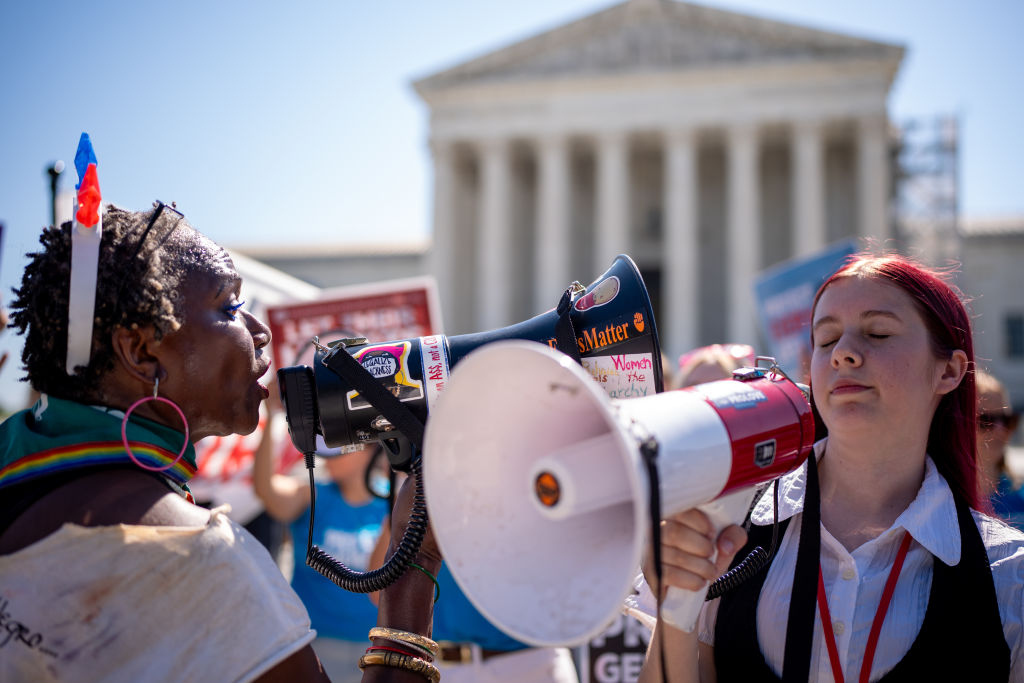
We’re now in the final stretch of Supreme Court decision season, with the chime of the clock at 10 a.m. ET on most Mondays and Thursdays in June striking fear in the hearts of daily newsletter writers everywhere.
The court has decided 47 of the 61 cases heard this term, leaving just 14 cases to be resolved. With unreleased opinions piling up as the end of the term draws near, the court added an extra release day on Friday. It’s rare that the court goes beyond June in handing down decisions, so the last of the opinions are expected this week. But if the justices push the season into July, you may find your TMD team protesting the schedule on the steps of the Supreme Court.
The remaining cases include some of the most high-profile and legally significant of the term: former President Donald Trump’s immunity case, a potential landmark ruling on the Chevron doctrine—the precedent directing the courts to defer to federal agencies’ interpretations of administrative law—and a case on state regulations of social media platforms.
But the last two weeks of opinions have showcased a court that continues to frustrate pat ideological characterizations. The released opinions that have drawn the most coverage—unsurprisingly—dealt with such hot-button issues as abortion and gun rights.
In the abortion drug case, the court ruled unanimously against the Alliance for Hippocratic Medicine (AHM) in the group’s bid to restrict access to mifepristone. The AHM argued that the Food and Drug Administration improperly expanded access to the pill—part of a regimen that induces abortion—when it relaxed prescription requirements in 2016 and 2021. Justice Brett Kavanaugh, writing for the majority, concluded that because the doctors represented by AHM don’t suffer harm from the rules around the drug, they lack the legal right (also known as “standing”) to challenge them. “A plaintiff’s desire to make a drug less available for others does not establish standing to sue,” he wrote.
AHM had argued that pro-life doctors would have to deal with the consequences when patients who suffer complications related to using mifepristone show up at their emergency rooms with abortion complications. But the court rejected all of the group’s theories of harm, finding that any effects on the doctors are far too attenuated and indirect—plus ruling in their favor would create a “sweeping” new doctrine of standing. “Firefighters could sue to object to relaxed building codes that increase fire risks,” Kavanaugh wrote of the potential consequences of the AHM’s argument. “Teachers in border states could sue to challenge allegedly lax immigration policies that lead to overcrowded classrooms.”
Kavanaugh emphasized that federal courts were the “wrong forum” for the doctors’ objections to the FDA’s rules. “The plaintiffs may present their concerns and objections to the president and FDA in the regulatory process, or to Congress and the president in the legislative process,” he wrote. “They may also express their views about abortion and mifepristone to fellow citizens, including in the political and electoral processes.”
In another closely watched case, United States v. Rahimi, the court delivered an 8-1 opinion that concluded a federal law that bars people under domestic violence restraining orders from owning guns does not violate the Second Amendment. The case revolved around Zackey Rahimi, who was prosecuted for possessing a firearm while subject to a domestic violence restraining order—filed by his girlfriend—which had suspended his firearm license. Following the court order, while investigating shootings in which he was a suspect, police secured a warrant to search Rahimi’s house and found a pistol and a rifle. Prosecutors subsequently indicted him on one count of gun possession while under a domestic violence restraining order, which he appealed, arguing that the federal criminal statute, Section 922(g)(8), under which he was indicted violated the Second Amendment.
It was the first Second Amendment case the court has taken up since the New York State Rifle & Pistol Association v. Bruen decision two years ago, which established a “constitutional text and history” test for evaluating gun laws. Bruen held that restrictions on gun ownership need be “consistent with the nation’s historical tradition of firearm regulation” to pass constitutional muster—in other words, new gun laws need to have some sort of historical analogy to how firearms were restricted in the colonial period and around the time of the ratification of the Second Amendment. The 5th U.S. Circuit Court of Appeals heard Rahimi’s appeal and agreed that Section 922(g)(8) is unconstitutional by narrowly applying Bruen’s test, concluding that there was not a “well-established and representative historical analogue” firearm regulation.
The Supreme Court reversed the 5th Circuit decision, articulating a more flexible application of Bruen. “Some courts have misunderstood the methodology of our recent Second Amendment cases,” Chief Justice John Roberts wrote in the majority opinion. “These precedents were not meant to suggest a law trapped in amber.” He added that “the law must comport with the principles underlying the Second Amendment, but it need not be a ‘dead ringer’ or a ‘historical twin.’”
The opinion was nearly unanimous, with only Justice Clarence Thomas dissenting. But more than half the bench—including Justices Sonia Sotomayor, Neil Gorsuch, Amy Coney Barrett, Ketanji Brown Jackson, and Kavanaugh—penned concurrences, highlighting the diversity of interpretations of the Bruen text and history test.
But Thomas, the author of the Bruen opinion, believed the 5th Circuit got it right, contending that “not a single historical regulation justifies the statute at issue.” He also objected to the lack of due process in Section 922(g)(8) since it hinges on protective orders rather than criminal convictions. “The question is whether the government can strip the Second Amendment right of anyone subject to a protective order—even if he has never been accused or convicted of a crime,” he wrote. “It cannot.”
Roberts’ opinion clearly didn’t settle all the questions prompted by Bruen, but it did signal a move away from the rigid applications of the “text and history” test that Thomas would prefer. “Historical regulations reveal a principle, not a mold,” Barrett wrote in her concurrence. As our friend David French wrote, the justices in the majority “clarified their approach to text, history and tradition in a way that freed lower courts from the straitjacket of finding precise historical analogies.”
Even if Thomas was outnumbered on Rahimi, he did have his day in the sun last week in a separate gun case, authoring the majority opinion in a 6-3 case that struck down a Bureau of Alcohol, Tobacco, Firearms and Explosives (ATF) rule banning bump stocks, an attachment enabling semi-automatic guns to fire at a faster rate. Unlike Rahimi, this case centered on a provision of the National Firearm Act of 1934 defining machine guns. The Justice Department reversed its interpretation of the act regarding bump stocks in 2018—redefining machine guns to include weapons fitted with bump stocks—in the wake of the Las Vegas mass shooting, where the gunman used the attachments to kill 58 people and wound hundreds more. Owning machine guns is largely restricted under federal law.
Thomas argued that the statute at hand clearly defines a machine gun as a weapon that can shoot “automatically more than one shot, without manual reloading, by a single function of the trigger.” The court found that while using a bump firing technique and or a bump stock with a semi-automatic weapon can have the effect of shooting multiple rounds in quick succession, it still involves multiple functions of the trigger. Therefore, a gun equipped with a bump stock does not qualify as a machine gun, and the Trump administration Justice Department had overreached in its rule change.
Sotomayor argued in a dissent joined by Justices Elena Kagan and Jackson that the ordinary definition of a machine gun would include weapons equipped with bump stocks. “When I see a bird that walks like a duck, swims like a duck, and quacks like a duck, I call that bird a duck,” Sotomayor wrote. Justice Samuel Alito penned a concurrence that sympathized with Sotomayor’s argument while siding with Thomas on the law. “There can be little doubt that the Congress that enacted [the Firearm Act] would not have seen any material difference between a machine gun and a semiautomatic rifle equipped with a bump stock,” he noted. “But the statutory text is clear, and we must follow it.”
“Congress can amend the law—and perhaps would have done so already if ATF had stuck with its earlier interpretation,” Alito added. “Now that the situation is clear, Congress can act.”
The court released a series of other opinions with policy implications, including in Moore v. United States. In a 7-2 decision, the court upheld the constitutionality of a one-time tax on unrealized gains for individual investors who own at least a 10 percent share of a foreign company—included in the 2017 Tax Cuts and Jobs Act. In one of the more narrowly decided cases, in a 5-4 decision the justices upheld the government’s current requirements for notifying illegal immigrants about their asylum court dates, which can sometimes lack key information. Gorsuch joined the three liberals—Jackson, Sotomayor, and Kagan—in the dissent.
The justices also decided on their fair share of cases in the legal weeds, including several dealing with criminal law. In Chiaverini v. City of Napoleon, Ohio, the court held that a prosecution proving probable cause for one charge in a criminal case does not bar a Fourth Amendment malicious-prosecution claim regarding other baseless charges. The court also addressed expert testimony in two separate cases dealing with the Federal Rules of Evidence and the Sixth Amendment’s right of defendants to confront witnesses in their trials. (Keep tuning into Advisory Opinions for a case-by-case breakdown.)
For at least some court watchers, the best is yet to come, and they’re growing impatient with what they see as the court dragging its feet. The court not only heard a relatively small case docket this term but has also issued rulings at one of the slowest rates in the last half-century.
But aside from the pace of decisions, perhaps what has been notable in recent weeks is a court defying the conventional 6-3 conservative/liberal divide, with “liberal” justices joining with “conservatives.” The court has shown an unusual amount of consensus and cross-ideological splits in divided cases. For Politico earlier this month, Sarah and economist Dean Jens analyzed the data from the court’s previous term, showing a “3-3-3” court with the Republican-appointed justices split into two separate groups based on their ruling patterns rather than one six-justice conservative block. Their surprising findings include the fact that “conservative” justices like Kavanaugh and Roberts side more often with Jackson, Kagan, and Sotomayor than with Thomas.
As Sarah and Jens wrote, “Ideology alone can’t explain most of the outcomes at the Supreme Court.”
Worth Your Time
- An Instagram account started as a pandemic-era lark by a mom and her dancer daughter has generated brand deals and fame—and hundreds of male followers. “The daughter loved coming up with creative posts. She told her mom she wanted to become an influencer, a ‘dream job’ she could pursue after school and dance practice,” Katherine Blunt reported for the Wall Street Journal. “To reach the influencer stratosphere, the account would need a lot more followers—and she would have to be less discriminating about who they were. Instagram promotes content based on engagement, and the male accounts she had been blocking tend to engage aggressively, lingering on photos and videos and boosting them with likes or comments. Running them off, or broadly disabling comments, would likely doom her daughter’s influencer aspirations. … The mom said yes. And with that, she grew to accept a grim reality: Being a young influencer on Instagram means building an audience including large numbers of men who take sexual interest in children.”
- At the People’s Convention, organized by Turning Point U.S.A., January 6 came up a lot. It’s “a topic that cleaved Trump from many of his fellow Republicans at the time, but has increasingly become an applause line up and down the party,” David Weigel reported for Semafor. “The re-nomination of Trump, who takes the stage at rallies to a tape of the national anthem he recorded with Jan. 6 defendants, has cemented its place. ‘Anyone that wants to continue to shame us for January 6 can go to hell,’ Georgia Rep. Marjorie Taylor Greene told the crowd on Friday. The intervening years have given conservative activists time to build a new folk mythology around the 2020 election and Capitol riot and develop them into a unified message at events like these. That message: This party, led by Trump, was trying to save democracy.”
Presented Without Comment
The Hill: [North Dakota Gov. Doug] Burgum Defends Using ‘Dictatorship’ to Describe Biden Administration
Also Presented Without Comment
Politico: Trump Floats UFC-style Migrant League Amid Border Crisis
“I said, ‘Dana I have an idea. Why don’t you set up a migrant league of fighters and have your regular league fighters,” Trump said, “and then you have the champion of your league — these are the greatest fighters in the world — fight the champion of the migrants.’” The suggestion drew laughter and applause from the crowd, a response that continued as he spoke more about the concept.
“I think the migrant guy might win,” Trump said, adding that [Ultimate Fighting Championship President Dana] White “didn’t like that idea too much.”
Also Also Presented Without Comment
Reason: New Virginia Law Will Let Anyone Harvest Roadkill Anytime of Year
In the Zeitgeist
We can sense copy editors everywhere twitching as they read the title of Coldplay’s newest single: “feelslikeimfallinginlove.” Despite the fact that the band’s shift and space keys were apparently broken when they named it, the song is vintage Coldplay and we’re into it.
Toeing the Company Line
- In the newsletters: The Dispatch Politics team took a look at Republican efforts to boost their ground game in Nevada, Nick argued (🔒) Trumpism is in its post-policy era, Jonah panned unity for unity’s sake by way of a story about Nazi raccoons (no, really), and Chris explained (🔒) what’s at stake in this week’s debate. Plus, in the inaugural edition of Dispatch Faith, Michael broke down what it’s all about and Karen Swallow Prior laid out what Christian nationalists could learn from literature.
- On the podcasts: Sarah and David unpacked the latest Supreme Court decisions on Advisory Opinions and Jonah ruminated on unity in a solo episode of The Remnant. On today’s Dispatch Podcast, Jamie is joined by Princeton’s Dr. Shilo Brooks to discuss how looking to the past can save the next generation.
- On the site over the weekend: Guy Denton reviewed Richard Linklater’s new movie, The Hitman, and Hannah Long returned to Chinatown on the film’s 50th anniversary.
- On the site today: Charlotte reports on the Muslim soldiers fighting for Israel and Carl Graham explains the ins and outs of tactical nuclear weapons.
Let Us Know
How closely do you watch Supreme Court decisions? Has this term challenged ideas about a solid “conservative” bloc of justices?




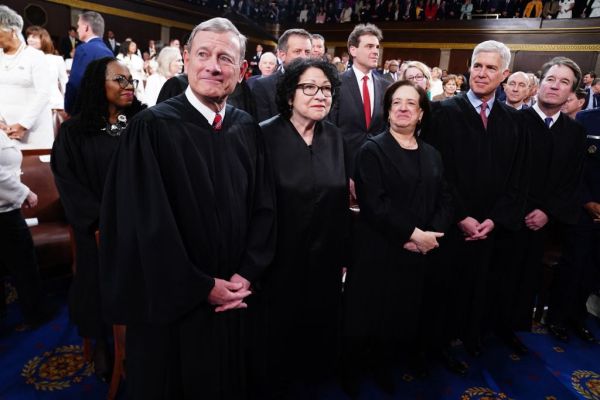
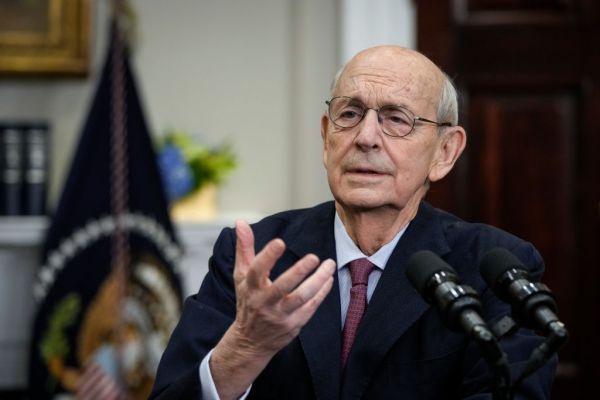
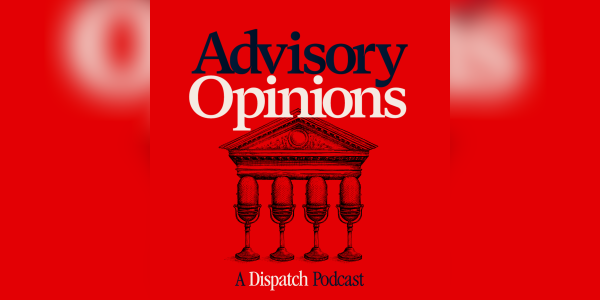
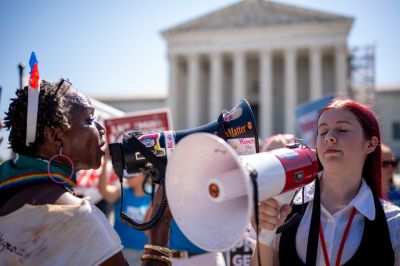
Please note that we at The Dispatch hold ourselves, our work, and our commenters to a higher standard than other places on the internet. We welcome comments that foster genuine debate or discussion—including comments critical of us or our work—but responses that include ad hominem attacks on fellow Dispatch members or are intended to stoke fear and anger may be moderated.
With your membership, you only have the ability to comment on The Morning Dispatch articles. Consider upgrading to join the conversation everywhere.